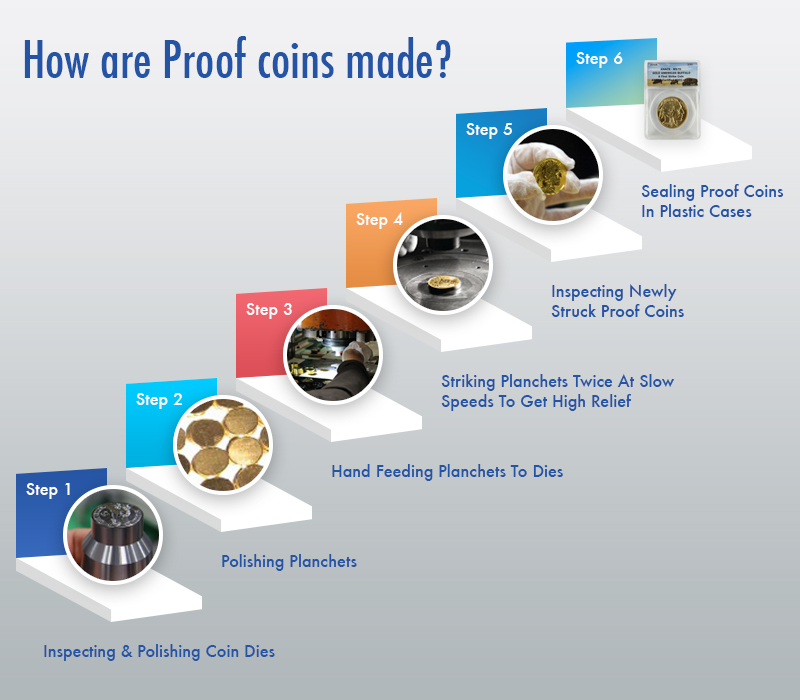'Proof Coin collecting' - Why you should do it!
Posted:
January 29, 2016

'Proof is not a grade; it is the method by which the coin is manufactured. Proof coin manufacturing has been in vogue since the 19th century. Initially, proof coins were struck for checking the dies and for archival purposes.[1] But now they are struck especially for coin collectors. Proof coin collecting has now reached a point where collectors try collecting the proof sets with all denominations for every year starting from 1936. Sometimes collectors get a particular year set to make wonderful presents for any milestones achieved in the family like birth, graduation, landing a job and so on.
Coin Collectors who specialize in 'Proof Coin collecting' will swear by the superiority ofProofcoins. These are the coins that are aesthetically perfect and struck with great precision using specially polished planchets (blank coins). Even the dies that are used are inspected thoroughly and polished. Proof coins are the pride of a mint engraver. If there is wear and tear, the dies are immediately replaced. Special care is taken to make sure proof coins are made with zero errors and have extremely brilliant mirror-like surfaces. Brilliant Proof coins have the highest grading i.e. PR 70. This is one of the main reasons why you should collect Proof coins. Now let's see how they are made.
How are Proof coins made?
- The Proof dies are inspected thoroughly, polished and re-polished after every 15 or 20 impressions.
- The planchets are polished to a high degree to get perfect coins.
- The planchets are then hand fed to the coin press one by one.
- The coins get struck at very high pressure once or twice slowly to make sure that they get high relief designs and clear details.
- The newly struck coins are inspected for any blemishes.
- The inspected coins are then sealed in plastic cases to protect from scratches.
Proof Coins and Sets
From the year 1936, the United States mint released proof coins of all the denominations (except for the dollar!). They became available both as individual coins and as a set. Most early proof coins exhibit a frosted effect and are called the Frosted Proofs. In recent years, a cameo effect is given to provide mirror-like surfaces and contrasting frosted effect for raised surfaces. The Proof coins from 1936 to 1954 were packaged in cardboard boxes. From 1955, the Proof sets were placed in transparent cellophane holders called flat packs.Early Proof coins
The Early proof coins were called the Matte Proof coins with granular surfaces instead of frosted ones. They were released as individual coins from 1908 to 1916. Some Silver Dollar Matte proofs were also released in 1921 and 1922.Regular Proof sets
The Proof sets struck after 1936 were a five coin set. They werestruck till 1942, when the production was stopped for the Second World War. It was resumed in 1950 and continued till 1972. From 1973, the dollar was included and from 1999 to 2008 the Proof sets included the State quarters released each year. Later Proof sets also included the Presidential coins and other commemorative coins. Proof coin collectors pay a premium for Proof sets with errors in them! For instance, the Dime in Proof sets of 1967, 1970, 1975 and 1983 do not have the mint mark and these come at premium prices.Prestige Proof sets
Special Proof sets containing a commemorative dollar along with the rest of the denominations were released from 1983 to 1997. These were called the Prestige Proof sets.Silver Proof sets
Silver Proof sets were initiated in the year 1992 by the U.S. mint. These sets contain coins that are 90% silver and provide an excellent option for Proof coin collectors who want the pleasure of owning a beautiful yet collectable Proof set. From the way they are created to the way they are packaged and the variety they provide, Proof Coin sets are unique in all respects. They add immense value to a coin collection by virtue of being the highest quality coin possible. Proof Coin collectinghelps a beginner to graduate into the realm of a serious collector without burning the pockets too much, as Proof sets can start as low as $30.So, have you started your 'Proof coin collection' yet? Browse for our Proof coin sets ReferencesThis entry was posted in General on January 29, 2016 by lavanya kannan

Leave a comment